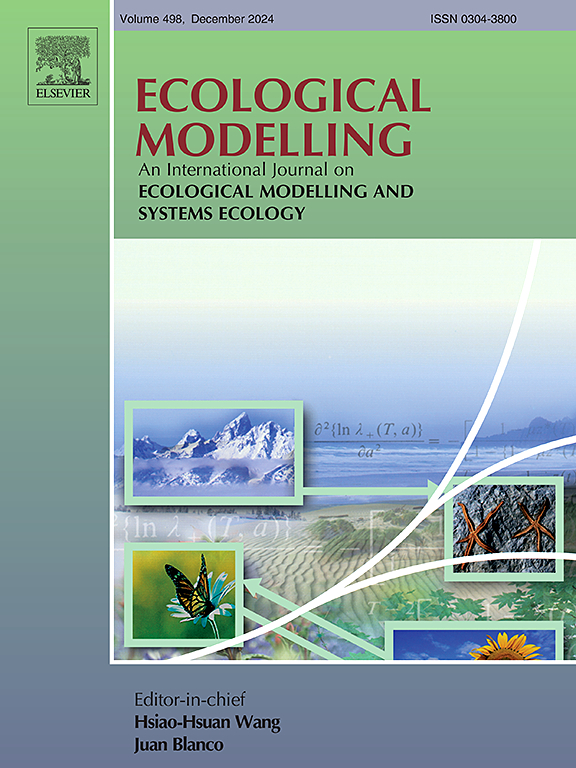帕尔地区当前生物气候适宜性及气候变化对可可念珠菌入侵风险的影响
IF 2.6
3区 环境科学与生态学
Q2 ECOLOGY
引用次数: 0
摘要
可可冻荚腐烂病(Moniliophthora roreri)传入巴西亚马逊地区增加了帕拉州可可产区虫害入侵的风险,有可能造成高达 100% 的产量损失,热带美洲爆发虫害时也曾出现过这种情况。因此,我们的目标是确定并量化潜在的和未来的生物气候适宜性,以及 M. roreri 迁移的风险途径,以支持帕拉州植物检疫防御管理的战略规划。生态位模型是利用该害虫在热带美洲的 49 个发生点、海拔数据、当前条件下的五个生物气候变量,以及根据 WorldClim 上的耦合模型相互比较项目第 6 阶段(CMIP6)对 2041-2060 年和 2081-2100 年期间的 SSP1-2.6 和 SSP5-8.5 途径进行的预测建立的。该模型显示,朱鲁蒂、雅卡里亚坎加、圣塔和奥里克西米纳是生物气候入侵的高风险地区,而可可生产区(特兰萨马佐尼卡和特兰萨梅塔)则具有广泛的潜在生物气候适宜性。所有未来情景都表明气温升高、降水量减少,巴拉州的气候可能不适合害虫生存,与潜在预测相比,SSP1-2.6 路径下的降水量分别减少了 5.3% 和 3.8%,而 SSP5-8.5 路径下的影响更大,2041-2060 年和 2081-2100 年期间的降水量分别减少了 5.7% 和 12.12%。在气候变化条件下,有些可可产区的生物气候风险潜力为中低,病原体与寄主的关系可能会发生变化,特别是在横马佐尼卡地区。生态位模型表明,需要在 Juruti 和 Jacareacanga 采取紧急监测行动,协助规划和决策,以防治 M. roreri,保护植物健康,确保帕拉州可可生产链的竞争力。本文章由计算机程序翻译,如有差异,请以英文原文为准。

Current bioclimatic suitability and climate change impacts on the risk of cacao moniliasis invasion in Pará
The arrival of cacao frosty pod rot (Moniliophthora roreri) in the Brazilian Amazon increases the risk of pest invasion in cacao-producing areas of Pará, potentially causing losses of up to 100 % of production, as observed in outbreaks of the pest in Tropical America. Thus, the objective was to identify and quantify the potential and future bioclimatic suitability, as well as risk pathways in the movement of M. roreri, to support the strategic planning of phytosanitary defense management in the state of Pará. The ecological niche model was developed using 49 occurrence points of the pest in Tropical America, elevation data, five bioclimatic variables under current conditions, and projections from SSP1-2.6 and SSP5-8.5 pathways for the periods 2041–2060 and 2081–2100, based on the Coupled Model Intercomparison Project Phase 6 (CMIP6) available on WorldClim. The model indicated high bioclimatic risk areas for invasion in Juruti, Jacareacanga, Terra Santa, and Oriximiná, as well as broad potential bioclimatic suitability in cacao-producing regions (Transamazônica and Transcametá). All future scenarios suggest an increase in temperature, a decrease in precipitation, and a potentially unsuitable climate for pest survival in Pará, with reductions of 5.3 % and 3.8 % under the SSP1-2.6 pathway, and greater impacts under SSP5-8.5, with 5.7 % and 12.12 %, respectively, for the periods 2041–2060 and 2081–2100, compared to the potential projection. There will be cacao-producing areas with medium to low bioclimatic risk potential under climate change conditions, where the pathogen-host relationship may undergo changes, especially in the Transamazônica region. The ecological niche model indicates the need for urgent monitoring actions in Juruti and Jacareacanga, assisting in planning and decision-making to combat M. roreri, protect plant health, and ensure the competitiveness of the cacao production chain in the state of Pará.
求助全文
通过发布文献求助,成功后即可免费获取论文全文。
去求助
来源期刊

Ecological Modelling
环境科学-生态学
CiteScore
5.60
自引率
6.50%
发文量
259
审稿时长
69 days
期刊介绍:
The journal is concerned with the use of mathematical models and systems analysis for the description of ecological processes and for the sustainable management of resources. Human activity and well-being are dependent on and integrated with the functioning of ecosystems and the services they provide. We aim to understand these basic ecosystem functions using mathematical and conceptual modelling, systems analysis, thermodynamics, computer simulations, and ecological theory. This leads to a preference for process-based models embedded in theory with explicit causative agents as opposed to strictly statistical or correlative descriptions. These modelling methods can be applied to a wide spectrum of issues ranging from basic ecology to human ecology to socio-ecological systems. The journal welcomes research articles, short communications, review articles, letters to the editor, book reviews, and other communications. The journal also supports the activities of the [International Society of Ecological Modelling (ISEM)](http://www.isemna.org/).
 求助内容:
求助内容: 应助结果提醒方式:
应助结果提醒方式:


